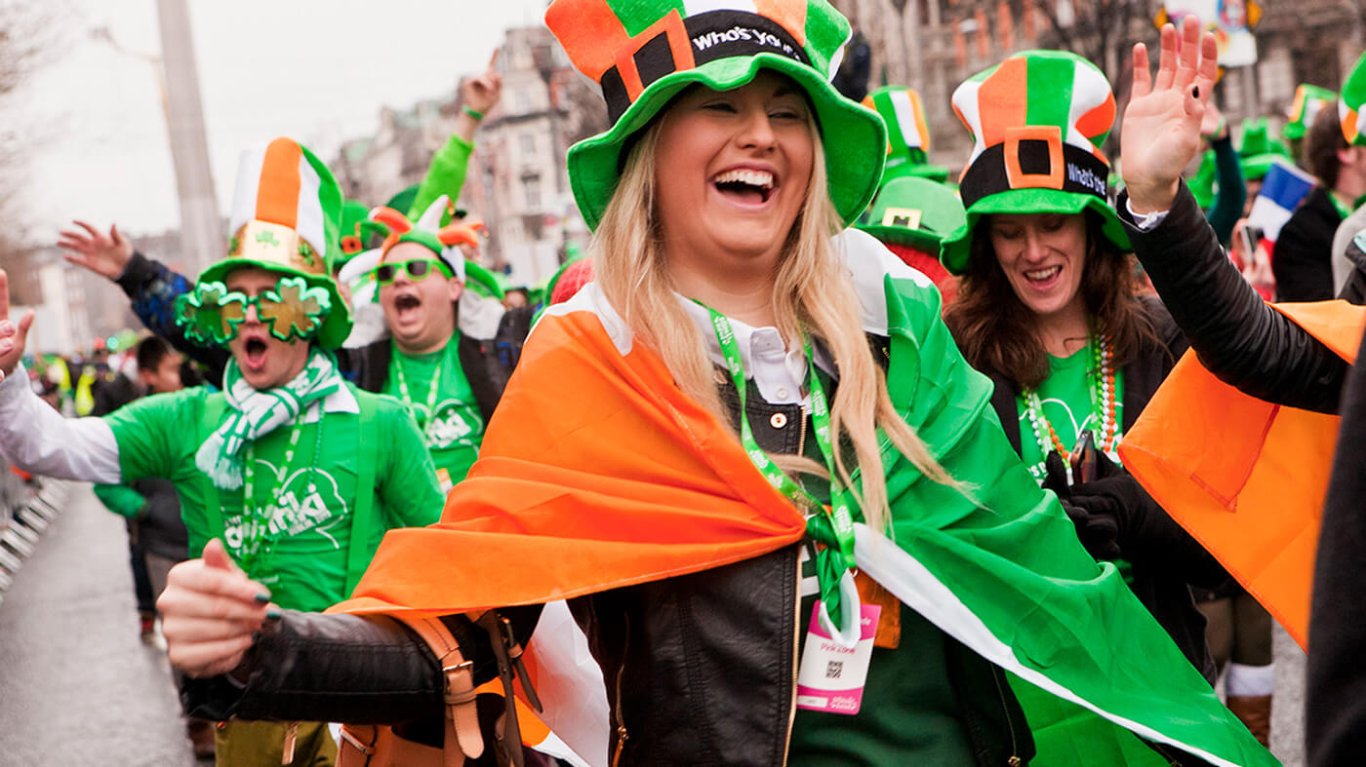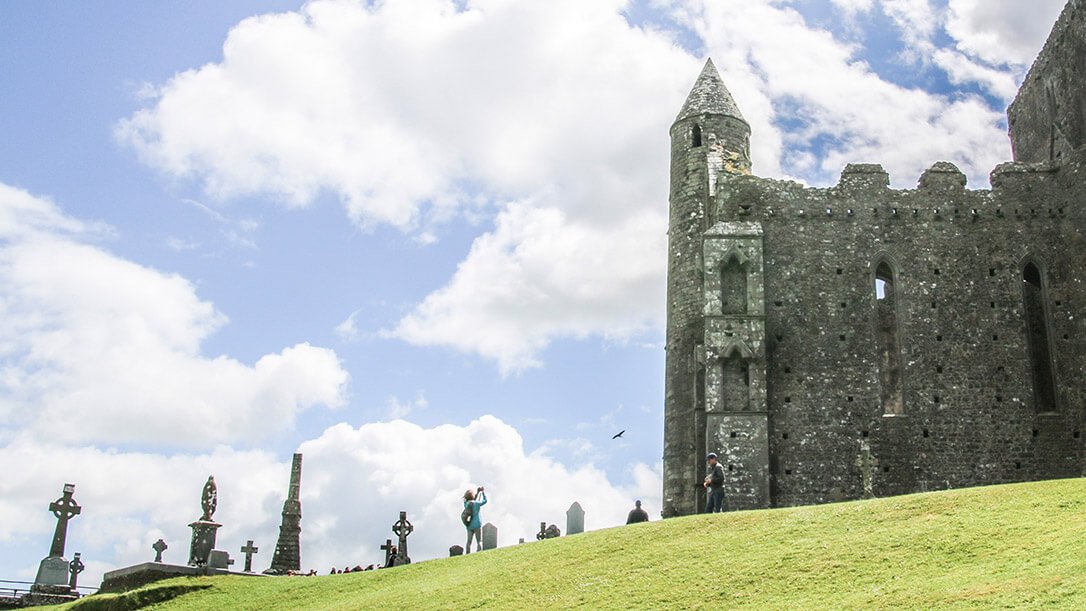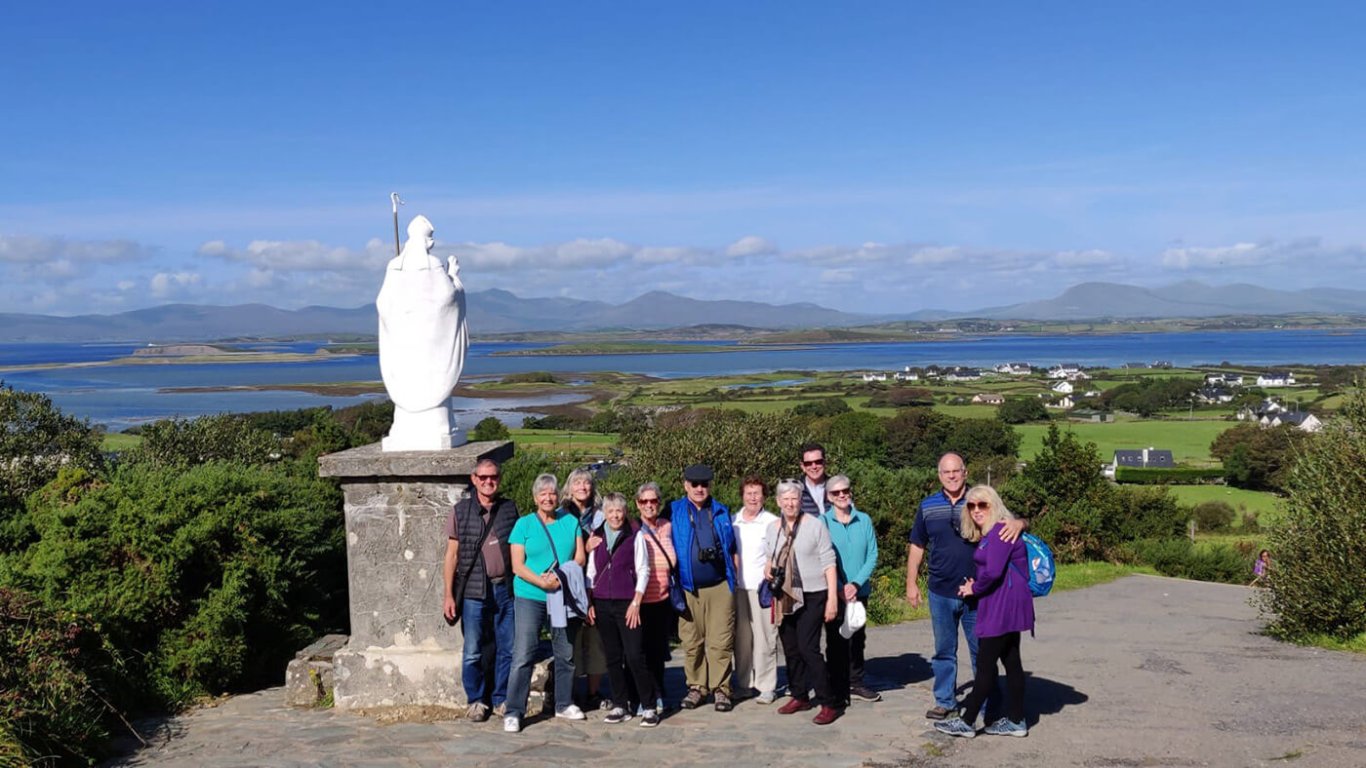Celebrating Saint Patrick's Day is a big deal. Not only in Ireland but around the world.
On March 17, everyone can be a little bit Irish.
Paddy's Day is celebrated all over Ireland, as well as in more countries globally than any other national festival.
This time is doubly special to us at Vagabond because it's when our small-group touring season starts each year.
Read on to discover the history of Saint Patrick's Day and the often surprising true facts behind Ireland's patron saint.
😇 Was Saint Patrick Irish?
Saint Patrick was not originally from the island of Ireland.
Although records are scant, it is believed that Patrick was born in Britain — possibly in Wales — at the end of the fourth century.
At that time, Britain was a Roman colony. Historians believe that Patrick may have come from a Roman family. To those who knew him, Patrick's name would have been Patricius and he would have spoken Latin.
Patrick is said to have come to Ireland twice. He was first abducted by pirates and brought to Ireland as a teenage slave.
He returned years later as a priest to spread the message of Christianity to then pagan Ireland.
⛪ Ireland Would Still Be Pagan... Maybe
Saint Patrick is most famous for converting Ireland to Christianity.
The Rock of Cashel is a spectacular monastic complex in Tipperary, known as the site where Patrick baptised the King of Munster.
But it's important to not that, if Patrick had chosen to convert Belgium instead, Christianity would probably have reached Irish shores anyway.
Patrick wasn't actually the first or only holy man to evangelise in Ireland. Earlier — but less well-known — missionaries arrived. They include Palladius, who was the first bishop of Ireland.
So even without Patrick, Ireland would probably still celebrate occasions like Christmas.
And the fact is that, even with the legacy of Patrick, pagan traditions still live on in Ireland.
☘️ March 17 Would Be Just Another Day
Without Patrick, the middle of March would be quite dull in Ireland.
Sure, you could still see beautiful wildflowers and leaping lambs on award-winning small-group tours in March.
But why was March 17 selected to celebrate Paddy?
Well, that date marks the day of his death. This was said to be in the year 462AD.
You can actually visit the purported grave of Saint Patrick at Downpatrick, in modern-day Northern Ireland

Above is one of our Driftwood tour roups visiting the purported grave of St. Patrick on their 6 Day Northern Island Tour.
🐍 Ireland Would (Possibly) Have Snakes
Without St. Patrick, would Ireland be riddled with snakes?
Folklore says that St. Patrick evicted all reptiles from Ireland. That's why there are no snakes to be found on the island to this day!
Science contests that Ireland never would have had snakes anyway.
This is because the island was almost entirely covered in the last Ice Age around 13,000 years ago.
Some believe that the legend of the snake-banishing was developed to symbolise Saint Patrick removing pagan druids and heathen ways from Ireland.
Whatever the reason, we are glad and grateful to Paddy that there are no snakes — or any dangerous wildlife — in Ireland.
🥳 The World Would Have One Less Party!
Nowadays, Patty's Day is a raucous celebration of Irishness.
Parties are held all over the island of Ireland. Events happen from Tokyo to Tbilisi to Timbuktu (maybe).
In Chicago, the parade is enormous and the river is dyed green! Across the world, people cook Irish recipes, drink green beer and illuminate landmarks with emerald spotlights.
Back in Dublin, the Saint Patrick's Festival has grown into a large-scale public celebration. It now takes place over the course of a week, with dozens cultural events attracting thousands of visitors.
In tiny villages and big cities across Ireland, all types of colourful characters traditionally take part in the annual Saint Patrick's Day parade.
The participants include marching bands, sports teams, themed 'floats' representing local businesses, police and firefighters and not forgetting farmers showing off vintage tractors and sometimes even farm animals.

But it hasn't always been thus.
The feast of Saint Patrick started as a church holiday sometime in the 17th century. It wasn't directly associated with Irishness at first.
Paddy's Day parties as we know them only really got started once Irish emigrants started to celebrate their identity in mid-20th century North America.

Without Saint Patrick or the festival his legend has spawned, we wouldn't have any of this.
But without emigration, Saint Patrick's Day probably wouldn't have reached its current global status.
Find out more about how Irish people celebrate Paddy's Day in Ireland
💚 Green Might Not Be Ireland's Colour
The colour green is strongly associated with Saint Patrick (and Ireland).
But it hasn't always been so.
In the early 20th century, Irish sports teams used to wear royal blue as their colour.
And the traditional flag of Saint Patrick is actually a red diagonal cross on a white background.
So just how did the colour green become associated with Ireland and Saint Patrick?
Well, the obvious answer is that Ireland itself is very green. The hills, the fields and the hedgerows are extremely well-watered and fertile!
But the less obvious answer is, once again, connected with religion.
Green was the colour of the Catholic Order of Saint Patrick.
Consequently, the 'wearing of the green' on March 17th became a tradition among Irish communities across Ireland and beyond, across the globe.

The 'wearing of the green' is still alive and well. Parade attendees in Ireland will typically dress in green; the crazier the outfit, the better!
And you don't partake in wearing green, friends and family — usually our mothers — ask, "Why aren't you wearing anything green?"
So if there wasn't a St Patrick's celebration each year, then maybe we wouldn't have to own a special, sparkly piece of green clothing for the occasion!
❌ Patrick-Less People & Places
Ireland is awash with people and places associated with Saint Patrick.
You can't swing a cat in rural Ireland without hitting a holy well, or water spring, that was purportedly blessed by the man himself. Virtually every townlond boasts a Saint Patrick's Well.
If you've ever come on tour with us, one of our friendly VagaGuides will undoubtedly have shown a holy well to you.

Here are some more places directly linked to the legend of Patty:
- There's a beach called Travelahawk in Wicklow town where locals say Patrick first came ashore (though this is a hotly disputed claim);
- According to folklore, Patrick herded sheep as a slave on the mountain of Slemish in Armagh;
- Legend also states that Patrick converted one king at the Rock of Cashel, in Tipperary, followed by another king on the Hill of Slane, in Meath;
- There's beautiful Saint Patrick's Cathedral in Dublin;
- Armagh is home of not one, but two cathedrals named after Saint Patrick;
- Downpatrick in Northern Ireland is where Saint Patrick was buried;
What's more, countless schools, colleges, sports teams and other clubs have named themselves after Ireland's patron saint; Saint Patrick's Athletic, for example, are one of Dublin's top soccer teams.
Without the saint, we wouldn't have enjoyed the acting talents of Patrick Stewart, Patrick Swayze or, for that matter, Patricia Arquette.
⛰️ No Holy Mountain
Of course, we can't talk about famous places associated with the saint without mentioning Croagh Patrick .
This conical mountain in Mayo has been a holy pilgrimage site for centuries.
What did Saint Patrick do on Croagh Patrick? He is said to have fasted for 40 days at the summit, where a small chapel now sits.
At 764 metres high — just over 2500 feet — the mountain doesn't sound like a huge challenge. But on Reek Sunday in July, thousands of pilgrims climb it, some barefoot or even on their knees (as penance).
If the mountain wasn't called after Patrick, maybe it would just be called Croagh, which means stack.
Or 'The Reek', as many locals still refer to it.
Instead of receiving spiritual rewards from a pilgrimage, climbers would still be rewarded with the beautiful views of Clew Bay and its 100s of islands.

Croagh Patrick is one of our favourite places to go adventuring along the Wild Atlantic Way touring route.
Climb Croagh Patrick with us, losing a sin with every step, on our 7 Day Magnetic North Adventure Tour.
Don't worry! We won't insist you go barefoot.
In Summary... Sláinte!
It seems odd to think of March passing each year without St. Patricks Day.
But as you know, we Irish love a party.
So we probably would have created some other national festival to enjoy a day off together.
- Cú Chulainn Day to celebrate the mythological Celtic Warrior
- A Pirate Queen Festival to mark the legend that is Grace O'Malley
- Brian Boru Day after the legendary high king of Ireland
- Or something silly like World Leprechaun Appeciation Week or Potatopalooza
It's all a moot point.
Thankfully we don't have to worry about alternatives because every year we get busy celebrating Patrick himself!
Whatever you're doing on March 17, raise a glass and say sláinte (cheers) to have a very Happy St Patricks Day!











